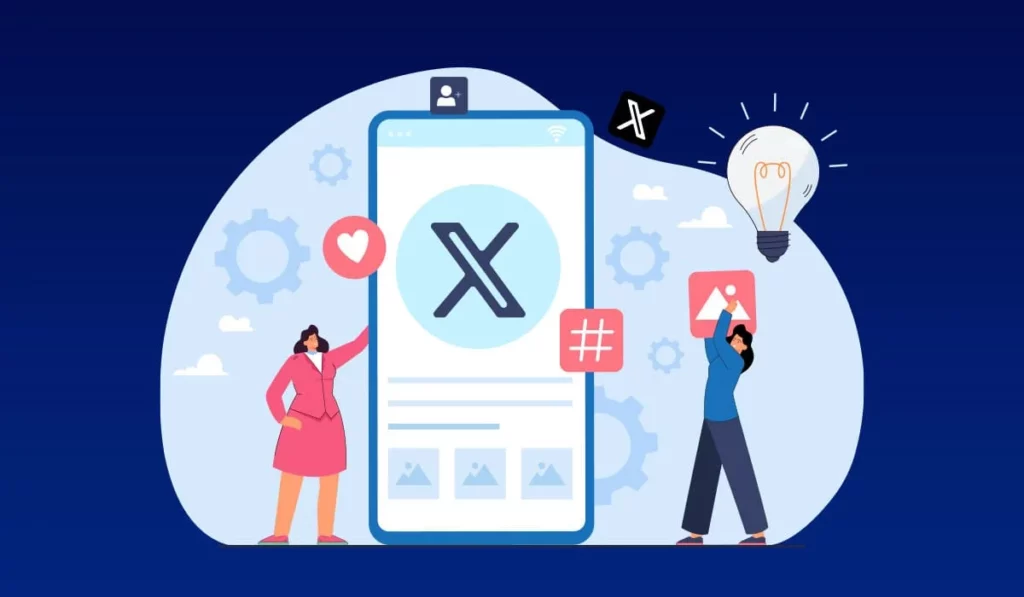Twitter Ads: How to Craft Engaging Promoted Tweets
Rony John06 Sep 2024
As one of the most popular social media platforms, Twitter has evolved into a powerful tool for online advertising.
It offers businesses new and innovative ways to connect with their target audience in real-time.
In this blog, we will learn more about running ads on Twitter, best practices, and strategies to help you maximize your campaign’s impact.
It is a popular social media platform that provides advertisers with a diverse user base and various ad formats to showcase their products or services.
Twitter ads have become an essential strategy for many businesses looking to increase brand awareness, drive website traffic, or boost sales.
One of the most effective ways of running ads on Twitter is through promoted tweets.
These paid advertisements appear in users’ timelines, search results, and other prominent locations on the platform.
Highly engaging promoted tweets have the potential to increase your reach and engagement rates significantly.
Promoted tweets can help you achieve your marketing objectives efficiently by crafting compelling content and targeting the right audience.

What’s Ahead
- Differences Between Organic Tweets and Promoted Tweets
- Key Differences
- Different Types of Twitter Ads
- A Step-By-Step Guide To Creating A Twitter Ads Account
- Visual Elements in Promoted Tweets
- Targeting Your Audience
- Budgeting and Bidding Strategies
- Key Metrics To Track For Promoted Tweets
- Best Practices and Tips
- Conclusion
Differences Between Organic Tweets and Promoted Tweets
Now, let’s take a look at the difference between Organic tweets and Promoted tweets.
Organic tweets are the standard tweets that you can post.
They will appear in your followers’ timelines and can be seen by anyone visiting your profile.
These tweets rely heavily on natural engagement, such as likes, retweets, and replies, to increase their visibility.
Organic tweets are free and ideal for regular updates, allowing you to easily engage with your followers and build your brand’s online presence.
On the other hand, promoted tweets are paid advertisements that appear in users’ timelines, search results, and profiles, even if they do not follow you.
These tweets are labeled usually as “Promoted” and offer enhanced targeting options to reach specific audiences based on demographics, interests, and behaviors.
Promoted tweets are designed to increase visibility, drive engagement, and achieve specific marketing goals such as boosting brand awareness or driving website traffic.
Key Differences
- Reach
Organic tweets depend on your followers and natural engagement, while promoted tweets use paid promotion to reach a broader, targeted audience.
- Cost
Organic tweets are free, whereas promoted tweets involve a cost based on bidding strategies like cost-per-click (CPC) or cost-per-impression (CPM).
- Control
Organic tweets rely on Twitter’s algorithm for visibility, while promoted tweets offer precise targeting options, providing more control over who sees the content.
- Purpose
Organic tweets are for regular engagement and updates, while promoted tweets are strategic, aiming to meet specific advertising objectives.
With this basic understanding of organic and promoted tweets, you can better strategize your social media efforts to maximize your brand’s impact through running ads on Twitter.
Different Types of Twitter Ads
When it comes to running ads on Twitter, you have several options.
These include
Single Image Ads
These ads feature a single compelling image to capture attention.
They are great for showcasing products, promoting events, or highlighting key messages visually.
Video Ads
Video ads on Twitter allow you to share engaging videos that can be up to 2 minutes and 20 seconds long.
They are perfect for storytelling, demonstrating products in action, or sharing customer testimonials.
Text Ads
Text ads are simple yet effective.
They consist of text (the usual length of a tweet – 250 characters) and can include a link or a hashtag to drive traffic or encourage conversation around a topic.
Carousel Ads
Carousel ads enable you to showcase multiple images or videos in a single ad unit.
Users can swipe through the carousel to see different visuals and messages, making them ideal for highlighting various products or features within a single campaign.
Follower Ads
Follower ads are designed to increase your Twitter following.
They promote your account to users who are likely to be interested in your content, encouraging them to follow you directly from the ad.
Takeover Ads
Takeover ads allow your ad to appear prominently in users’ timelines for a specified period.
They are designed to maximize visibility and impact by temporarily occupying prime ad space on Twitter.
Each type of Twitter ad offers unique advantages depending on your marketing goals – whether it’s driving engagement, increasing followers, or promoting specific products or content.
Choosing the right type of ad can help you effectively reach your target audience and achieve your campaign objectives on Twitter.
A Step-By-Step Guide To Creating A Twitter Ads Account
Running ads on Twitter can greatly improve your brand’s visibility and engagement.
But before you can dive into advertising, you need to ensure you have a Twitter account.
If you don’t have one yet, follow these basic steps to create a new account
- Visit the Twitter Sign-Up Page
Open your browser and go to Twitter’s sign-up page.
- Enter Your Information
Fill in your name, phone number or email address, and date of birth.
Click “Next” and follow the prompts to customize your experience.
- Create Your Account
Review your information and click “Sign Up.”
You will get a verification code through email or text message.
Enter this code within the specified time frame to successfully verify your account.
- Set Up Your Profile
Add a profile photo, cover photo, and bio to complete your profile.
This helps in establishing your brand identity on Twitter.
- Follow Relevant Accounts
Follow people, brands, and accounts related to your industry or interests to start building your network.
- Tweet and Engage
Make your first tweet and begin engaging with others to start building your presence on Twitter.
Once you have a Twitter account, you can get started and optimize your Twitter Ads campaigns step-by-step.
Selecting The Right Type Of Ad For Your Campaign Goals
When running ads on Twitter, it’s crucial to choose the ad type that aligns with your campaign objectives.
For brand awareness, video or takeover ads might be most effective.
For driving website traffic, single image or carousel ads could be your best bet.
Consider your target audience and the nature of your product or service when making this decision.
Crafting Compelling Tweet Copy
The success of your promoted tweets largely depends on the quality of your copy.
Creating engaging tweet copy is key to capturing your audience’s attention amidst the fast-paced Twitter feed.
Here are some tips for writing engaging tweet copy:
Be Concise and Clear
Twitter limits tweets to 280 characters.
Always use clear, concise, and understandable language to convey your message effectively.
Use Keywords and Hashtags
Incorporate relevant keywords and hashtags to increase discoverability, relevance, and freshness.
Include a Strong and clear Call-to-Action (CTA)
Encourage user interaction with a clear CTA, such as “Shop Now” or “Learn More.”
Make strong and compelling CTA’s like “Limited Time Offer” or “Don’t Miss This Last Chance” to show some urgency to get quick responses.
Highlight Benefits
Focus on what your audience will gain or experience by engaging with your tweet.
Personalize Messages
Tailor your messages to your target audience for better resonance.
Use Emojis
Emojis can add personality and visual appeal to your tweets.
Ask Questions
Encourage conversation by posing questions that elicit responses from your followers.
Visual Elements in Promoted Tweets
Using visually appealing images and videos can improve the effectiveness of your promoted tweets.
Here are some best practices for using visual elements in your Twitter ads:
High-Quality Images
- Resolution and Clarity
Always use high-resolution images that are clear and sharp.
Blurry or pixelated images can diminish your brand’s credibility and engagement.
Aim for images that are at least 1200 x 628 pixels for optimal display on Twitter.
- Relevance to Content
Ensure that the images you use are directly related to the content of your tweet.
Irrelevant visuals can confuse users and lead to lower engagement.
Video Specifications
- Format
Twitter allows you to submit video files in MP4 and MOV formats only.
Make sure that your videos are properly encoded for the best playback quality.
- Length
Keep videos concise, short, and minimal.
The recommended video length is between 15 seconds to 1 minute to retain viewers’ attention.
While you can upload videos up to 2 minutes and 20 seconds, shorter videos often perform better.
- Resolution
Aim for a minimum resolution of 720p (1280 x 720 pixels) for video quality.
This ensures your videos look professional and are easily viewable on different devices.
Brand Consistency
- Color Schemes
Use colors that reflect your brand identity.
Consistent color schemes help reinforce brand recognition and make your ads instantly recognizable.
- Fonts and Styles
Stick to specific fonts and styles that align with your brand’s overall design aesthetic.
This creates a consistent and compatible look across your social media platforms.
Captions and Text Overlay
- Adding Context
Use captions to provide context or highlight key messages in your visuals.
This can help convey your message even if users are watching without sound.
- Legibility:
Ensure that any text overlay is easily readable.
Use contrasting colors and large fonts to make your text stand out against the background image or video.
Call-to-Action (CTA) Buttons
- Visibility:
If you have a specific action you want users to take, such as “Shop Now” or “Learn More,” make sure your CTA is clearly visible in the visual.
Use bold colors or borders to make your CTAs stand out.
- Placement:
Position your CTA strategically in the image or video.
It should be in a spot that naturally draws the viewer’s eye but does not overwhelm the overall design.
Using GIFs and Animations
- Attention-grabbing:
Using GIFs can be an effective way to catch users’ attention quickly.
They can convey emotion or humor, making your brand feel more relatable.
- Short and Looping:
Ensure that GIFs are short and loop seamlessly to encourage viewers to watch them multiple times without losing interest.
A/B Testing Visuals
- Experimentation:
Conduct A/B tests with different images or videos to see which ones perform best.
Test various styles, colors, and formats to determine what resonates most with your audience.
- Analyze Performance:
Use Twitter Analytics to track the performance of different visual elements in your promoted tweets.
Focus on engagement rates, click-through rates, and conversion rates to identify successful visuals.
Utilizing User-Generated Content (UGC)
- Engagement
Including User Generated Content in your promoted tweets can create a sense of community and authenticity.
Sharing photos or videos from satisfied customers can enhance trust in your brand.
- Encourage Sharing
Remind or motivate your audience to share their experiences with your products or services.
Consider running campaigns that encourage users to post photos using a specific hashtag.
Adherence to Twitter’s Media Guidelines
- Guidelines Compliance
Familiarize yourself with Twitter’s media guidelines to ensure your visuals comply with their standards.
This includes avoiding excessive text on images and using appropriate content.
- Avoid Restricted Content
Ensure that your visuals do not include content that violates Twitter’s advertising policies, such as misleading images or inappropriate content.
Targeting Your Audience
When running ads on Twitter, you have access to the platform’s robust targeting options to make sure that your ads reach the right audience and achieve your campaign goals.
The targeting options on Twitter include:
- Demographics: Target users based on age, gender, language, and location to precisely match your desired audience.
- Interests: Reach users interested in specific topics or categories, ensuring your ads are seen by those who are most likely to engage.
- Behaviors: Target users based on their past actions on Twitter or off-platform behaviors, allowing you to connect with users who have shown interest in relevant activities.
- Keywords: Show your ads to users who have recently tweeted or engaged with specific keywords, making your campaign highly relevant and timely.
Budgeting and Bidding Strategies
Setting a budget for your Twitter Ads campaign is crucial for controlling costs and maximizing ROI.
Twitter offers both daily and total budget options.
Select between a daily budget to control your daily spend or a total budget for the entire campaign duration.
Choose a bidding strategy that aligns with your campaign goals, such as target cost bidding for consistent results or maximum bidding for more aggressive campaigns.
You can also use automatic bidding for Twitter to optimize your bids or choose maximum bidding to set a cap on what you’re willing to pay.
Key Metrics To Track For Promoted Tweets
When you are running ads for Twitter, tracking the key metrics can improve the effectiveness of your campaigns and make data-driven decisions for optimization.
The key metrics that you should focus on are
1. Impressions
Impressions refer to the number of times your promoted tweet is displayed on users’ screens.
Monitoring impressions helps you understand the reach of your ad campaign and how many times your tweet has been seen.
High impressions indicate good visibility, but it is also important to track how this visibility translates into engagement.
2. Engagement Rate
Engagement Rate measures the percentage of people who interacted with your promoted tweet out of the total number of impressions.
Engagements can include likes, retweets, replies, clicks, and shares.
This metric shows how compelling and relevant your content is to your target audience.
A higher engagement rate indicates that your tweet resonates well with users.
3. Click-Through Rate (CTR)
Click-Through Rate (CTR) is the ratio of users who clicked on a link, image, or hashtag in your promoted tweet compared to the number of impressions.
CTR is an important metric because it directly correlates to user interest and the effectiveness of your call-to-action (CTA).
A high CTR suggests that your ad copy and visuals are enticing enough to drive users to take action.
4. Cost Per Engagement (CPE)
Cost Per Engagement (CPE) calculates the average cost for each engagement with your promoted tweet.
The CPE calculation can help you assess the cost-effectiveness of your campaign.
Lower CPE means you are getting more value for your advertising spend, indicating efficient budget use and successful audience targeting.
5. Conversions
Conversions track the number of times users complete a desired action after engaging with your promoted tweet.
This could be anything from signing up for a newsletter, downloading an app, or making a purchase.
Conversions are a key metric for measuring the return on investment (ROI) of your Twitter ads, as they directly reflect the success of your campaign objectives.
6. Video Views
If you are using video ads, Video Views is a critical metric.
It can help you in measuring how many times your video has been watched.
You can also track metrics like view rate (the percentage of users who watched your video out of those who saw it) and completion rate (the percentage of users who watched your video to the end).
These metrics help you understand the effectiveness of your video content.
7. Follower Growth
Follower Growth measures the increase in your Twitter followers as a result of your promoted tweets.
It is particularly important for campaigns aimed at building your Twitter presence and growing your audience.
An increase in followers indicates that your content is attracting and retaining user interest.
8. Engagement Types
Break down the different types of engagements to get a detailed view of how users interact with your promoted tweet.
Track likes, retweets, replies, link clicks, and media views separately.
Understanding which type of engagement is most common can provide insights into user behavior and preferences.
9. Ad Spend
Ad Spend is the total amount of money you spend on promoted tweets.
Keeping an eye on your ad spend can benefit budget management.
Monitoring ad spend ensures that your campaign stays within financial limits while achieving desired outcomes.
10. Return on Ad Spend (ROAS)
Return on Ad Spend (ROAS) measures the revenue generated from your promoted tweets relative to the cost of running the ads.
A high ROAS indicates that your ads are generating significant revenue compared to their cost, demonstrating a successful campaign.
Best Practices and Tips
Now let’s check out some additional tips for running successful ads on Twitter:
Test Different Ad Formats
Experiment with various ad formats to see which performs best.
Twitter offers several ad formats, including single-image ads, video ads, carousel ads, and more.
By testing different formats, you can determine which ones resonate most with your audience and align with your campaign goals.
For example:
- Single Image Ads: Ideal for concise, impactful messaging with a strong visual.
- Video Ads: Good for storytelling, highlighting the benefits of a service, and demonstrating products in action.
- Carousel Ads: Perfect for showcasing multiple products or features in one ad.
Regularly analyzing the performance of each format can refine your strategy and invest in the most effective ad types.
Use Twitter Analytics
You can use Twitter Analytics to gain insights and optimize your campaigns.
Twitter Analytics provides valuable data on your ad performance, including impressions, engagement, and demographic information.
Use these insights to:
- Track Key Metrics: Monitor impressions, engagement rate, click-through rate (CTR), and conversions to measure the success of your campaigns.
- Identify Trends: Recognize patterns in user behavior and preferences to tailor your content.
- Optimize Targeting: Adjust your audience targeting based on analytics data to reach the most relevant users.
Continuously review and examine your Twitter Analytics so that it can help you in making data-driven decisions and improving your ad campaigns.
Engage with Your Audience
Respond to the comments and interact nicely with users to build relationships.
Engagement is a key component of a successful Twitter ads strategy.
By actively responding to comments, retweeting user-generated content, and participating in conversations, you can build stronger relationships with your audience.
Here’s how you can engage your target audience in a better way:
- Reply Promptly: Address comments and questions quickly to show that you value user interaction.
- Retweet and Share: Amplify positive user-generated content to build community and trust.
- Join Conversations: Participate in relevant trending topics and hashtags to increase visibility and engagement.
Active engagement can improve your ad performance while enhancing your brand’s reputation and loyalty.
Monitor Trends
Stay updated on the latest trends and incorporate them into your ad campaigns.
Twitter is a dynamic platform where trends and conversions can shift quickly.
By keeping an eye on trending topics and hashtags, you can:
- Stay Relevant: Align your ad content with current trends to increase relevance and engagement.
- Tap into Popular Conversations: Join trending conversations to expand your reach and visibility.
- Adapt Quickly: Adjust your ad strategies to capitalize on emerging trends and opportunities.
Monitoring trends always make sure that your ads remain timely and appealing to your audience.
Conclusion
Running ads on Twitter can be a highly effective way to reach and engage with your target audience.
By understanding the different types of Twitter ads, crafting compelling copy, and using precise audience targeting, you can maximize the impact of your campaigns.
Always track the key metrics of Twitter ads and follow best practices to ensure that your promoted tweets drive the desired results.
Checkout our related blogs as well:
- Ultimate Guide To Socal Media Ads
- How to Create Effective Facebook Ads That Convert
- Instagram Ads: Best Practices for High Engagement
- LinkedIn Ads: How to Reach Professionals Efficiently
- Pinterest Ads: Everything You Need To Know
- Benefits of Using Meta Ads to Advertise Your Business
Latest Post

5 Do’s and Don’ts When It Comes To SEO
 18 Sep 2023
Readmore
18 Sep 2023
Readmore
Want to learn more about the digital marketing service we provide?
Contact Us to Get Started!




